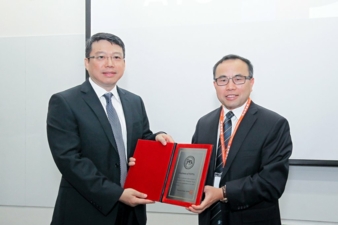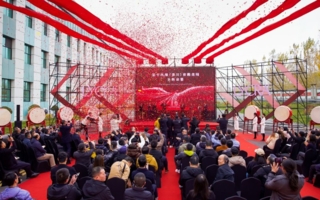10/10/2017 – The 14th Asian Textile Conference
“Disruptive Innovations for Textiles and the Supply Chain”
This year, the 14th edition of ATC was held in June in Hong Kong, hosted by the Institute of Textile & Clothing (ITC) of the Hong Kong Polytechnic University (HK PolyU)
An International Scientific Committee was organized for this 14th edition made up of not only professors from Asia but also France, the UK, Germany, USA, & Belgium. Over 400 attendees from 12 countries came to hear the speeches delivered by 5 plenary and 30 keynote speakers plus numerous oral presentations of papers as well as poster presentation from the East and West.
Six parallel sessions covered a number of interesting topics: Advanced Textile Processing, New, Advanced and Smart Materials for Textiles, Fashion Design and Technologies, Finishing, Dyeing, Surface Functionisation & Coating, Functional, Smart & High Performance Textiles, Green Processing Technologies for Textiles, Quality Management and Branding of Textiles and Fashion, Sustainable Fashion Supply Chain, Textiles for Emerging Technologies. In addition to speakers from the 8 member countries they came also from Italy, USA, UK, Turkey, Czech Republic, Bangladesh, & Thailand. The following are some highlights from the Opening speeches and Plenary Sessions. Topics covered reflected the issues FAPTA perceived as great importance.
Plenary Sessions
Prof Timothy Tong, President of HK PolyU, said, “Disruptive Innovations” is not only a concept but also the driving force of the future development of the textile industry. ITC, as a pioneer in innovation in the fashion and textile industry, ranks a world leader in research and citations. Prof John Xin, head of ITC and the conference chair, pointed out that ITC has played an important role in the cultivation of new talents in fashion and textile. Earlier this year, Hong Kong Research Institute of Textiles & Apparel (HKRITA) lead a group to the 45th International Exhibition of Invention of Geneva with 7 entries which won 9 awards including 3 gold, 4 silver and 2 special awards. Prof Wang Xungai, Chair of FAPTA and Director of Institute of Frontier Materials of Deakin University, Australia, whose university hosted the ATC event in 2015, pointed out the ATC conference not only provides a platform for sharing the latest research in textile technology by also for renewing and developing friendships as well as academia-business collaborations.
China’s textile & apparel industry situation
The first plenary session was delivered by Mr Sun Ruizhe, president of China National Textile & Apparel Council (CNTAC) and China Textile Engineering Society. He gave a comprehensive picture of China’s textile & apparel industry situation today supported with data and statistics. He described current China’s textile industry as one in transformation and upgrading with innovation driven technology for its further development. Despite recent slowing down in production and export, the industry still has great potential for growth & development from quantity strong to quality through green production. He said China has a complete and comprehensive textile & apparel chain, from raw material, fiber, production to end products like no other country – the value chain is unbeatable. While the coastal region is slightly slacking in textile activities, the Western region is growing especially Xinjiang. As its economy continues to grow, its consumption increases. It will transform from a supplier strong to a consumption huge market country. He emphasized the industry must consolidate, focus on material technology, enhance its product value, improve intelligent manufacturing, develop green production to achieve sustainable growth. The industry is no longer reliant on labour, but on innovation. The Belt & Road Initiative is bringing new opportunities for textile & apparel trade.
On a technical direction, Prof Yu Jianyong, academician of the Chinese Academy of Engineering share his knowledge on Functional Nanofibrous Materials and highlighted the recent progress in the research of functional nanofiber materials in China. Based on different physical, chemical or optical properties, nanofiber can be used to replace material for existing industrial and consumer products such as air filtration, insulation, and sensing and oil spill control. This alternative ensures sustainability for the future. He also described how electrospinning method has been applied to natural polymers, synthetic polymers, ceramics and carbon. Nanofibrous materials with complex architectures, such as porous fibers, core-shell fibers, alignment fibers, 2D nanofibers/nets, and nanofibrous aerogels, can be achieved. Presently it is the primary and most effective method used to prepare nanofibers.
The “boss” is not always right
Esquel Group’s chairman, Marjorie Yang, described her company’s strategy in the Era of Disruptive Innovation. She said in fact, her company thrive on a disruption approach as it results in innovative solutions. However, people in general do not like to make changes. We must accept that the “boss” is not always right. A company must develop a culture which allows employees to be independent critical thinkers and they can make mistakes but must learn from it. Esquel’s 5 “Es” are ethics, environment, exploration, excellence, education and dare to err. Through innovation, guided by sustainable concept, her company managed to reduce energy consumption by 44% and water by 64% in 10 year. She reminded that China’s domestic market is huge but challenging.
Innovation is a new idea
Ms Kim Wong, professor of practice in fashion marketing and retailing at HKPolyU in an energy charged speech shared her thoughts on Innovation, Interruption and Inspiration in the apparel industry. Innovation is a new idea to solve a problem or improve on a solution. Technology has changed the consumer behavior and expectation. It had been overlooked in the past but now it drives the industry - fashion is in an age of technology. It improves efficient production, saves time, and yields better quality products. It permits consumers to buy personalized products through their own design choices. They are no longer followers but leaders of trends. Due to this, the rule of design has been disrupted - sports chic and wellness known as Athleisure - is now the big trend. The smart phone technology has changed everything. It has made consumers better informed with up to the moment information and news than ever before. It has opened up a whole new way to sell and to buy - shopping globally and locally through e-commerce. Omni channel permits more options for buyers and for retailers who can reach a wider customer group. This technology offers designers go direct to the consumers, cost less to produce and reach farther & wider. It can shorten the fashion cycle and help realize the “See Now Buy Now” challenge.
Next Century for Textiles
Dr Kunihiro Hamada, president of Shinshu University in Japan articulated the strategy of Shinshu University for the ‘Next Century for Textiles’. Shinshu University is Japan’s leading textile university, focused in the research and new developments especially in fiber engineering that spans from nanofibers to fiber materials. In 2014, it established an interdisciplinary Cluster for Cutting Edge Research including 5 institutes. One of them was the Institute for Fiber Engineering (IFES) which promoted the creation of “frontier fibers” with various functions and capabilities, research into biological fibers and fibers for medical use through medical-engineering collaboration, and development of medical robots and control technologies. It also engaged in creation of smart textiles with new functions by merging the fields of nanotechnology and nanofiber, and research aimed at creation of fashions through technology innovations. More recently in 2016, it formed a new organization which consisted of 4 departments: Advanced Textile and Kansei Engineering, Mechanical Engineering and Robotics, Chemistry & Materials, and Applied Biology. Textile engineering is an important part of the engineering field which supports fundamental industries from clothing, food to housing.
CEO of HKRITA Mr Edwin Keh talked about the 4.0 concept for the fashion industry borrowed from the German’s Industry 4.0. “If we change we may be able to survive, but if we don’t we will lose”, he declared. There will be new entrants into the industry pushing out the old. Change from the traditional ways to meet the challenges of the future or less you will be pushed out. Companies like Amazon and Alibaba continuously come out with innovative approaches to manufacturing and sales giving other traditional companies little room to survive if they do not change. We need smart factories. We need cross industry collaboration. The biggest development is wearable technology. Our mobile phone is the heart of our lives. The clothing industry has not improved much in the past 10 years. Sustainable, interdisciplinary and functional is the way forward for the apparel industry
The Asian Textile Conference (ATC)
The Asian Textile Conference (ATC), a world leading biennial conference focused on the textile field has its roots dated back to 1991 when it held its first conference in India. Since then, it has been held in Korea, Hong Kong, Taiwan, Iran China and Australia, some locations more than once. ATC is a project of the Federation of Asian Professional Textile Associations (FAPTA), an organization initiated and established by the Korean Institute of Textile Engineers and Chemists in 1989 and now has 8 representatives from professional textile associations in Asia – from Australia, Taiwan, Hong Kong, India, Iran, Korea, Japan and China. It is a platform to provide scientists and researchers in all textile fields to share knowledge, new innovations in the textile science and engineering and to envision the new markets and new values created for the textile supply chain.
by Vicky Sung




